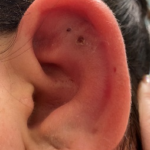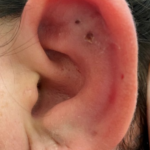Auricular Perichondritis after a “High Ear Piercing:” A Case Report
ABSTRACT:
Body piercings in sites other than the ear lobe are becoming increasingly popular. It is not uncommon for patients to present to the emergency department with complications resulting from body piercings. We present a 29-year-old female who underwent a “high ear piercing” which resulted in auricular perichondritis. Left untreated, this infection can progress and potentially result in permanent deformity of the external ear or invasive infection of the surrounding structures. It is important to properly diagnose auricular perichondritis, because unlike many more common soft tissue infections, which are usually due to common skin flora and are simply treated with anti-streptococcal or anti-staphylococcal antibiotics, auricular perichondritis is most commonly due to Pseudomonas aeruginosa. The treatment of acute auricular perichondritis specifically requires anti-pseudomonal antibiotic therapy, usually a fluoroquinolone, to avoid inflammatory and cosmetic complications. This case report focuses on the clinical diagnosis of auricular perichondritis, which can be easily misdiagnosed or mistreated on initial assessment in an emergency setting.
Topics:
Auricular perichondritis, ear piercing, cartilaginous piercing, otalgia.





